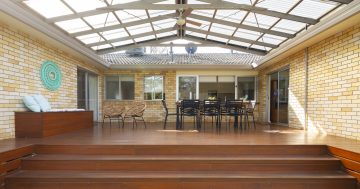Arianne Cohen* says that if you’re working from home, you shouldn’t sit at a desk all day when there are other rooms to use.
 “You should never sit for more than 10 minutes, if you possibly can,” says Galen Cranz.
“You should never sit for more than 10 minutes, if you possibly can,” says Galen Cranz.
The University of California College of Environmental Design Professor Emerita says your spine is designed to support you in an “S”-shape.
Standard chairs, however, force you into a hunched “C” that leads to weak abdominal and back muscles and causes neck pain.
Cranz, author of The Chair: Rethinking Culture, Body, and Design, has spent 30 years preaching the benefits of shifting positions throughout the workday.
She wants you to ditch the idea of working in one place and instead rotate between as many as seven.
Here’s her advice on how to make the most of each of them.
Kitchen
A tall kitchen island is arguably the best place to work at home.
Sit at the edge of a bar stool so your pelvis tips forward, allowing your abdominal and back muscles to strengthen.
This lets your legs remain active, which, research shows, helps avoid the high rates of heart attack and cancer that sedentary workers experience.
If you don’t have bar stools, try a saddle stool that makes you sit as if riding a horse.
And if you don’t have a kitchen island, create the height of one by placing a box on your kitchen table and putting your computer on top of it.
Your screen should be directly in front of your eyes and your keyboard at elbow height.
Perch like this for up to an hour at a time.
Dining room
Pull up a saddle chair, which tips your pelvis and spine into the right position and un-squishes your genitals.
“I don’t know scientifically how much damage is done by sitting on our genitalia, but I figure we’re probably paying a physiological price,” says Cranz.
Office
Who needs a desk in the age of paperless offices?
Cranz prefers lounge chairs that maintain the spine’s “S”-shape, with bent knees to relieve back pressure.
“My chair is connected to a computer on an arm, so I can swing my computer in front of me,” Cranz says.
“I just did my taxes in that position.”
If you must have a desk, Cranz likes options that let you adjust between sitting and standing.
Living room
According to a 2019 survey by training software firm TalentLMS, almost a third of remote workers camp out in the living room.
Cranz recommends a chaise lounge.
A music stand with a clip will revolutionise reading because you won’t need to hold the book.
Bedroom
The TalentLMS survey found that the bedroom is the office of one in six remote workers.
Create that same lounge chair position with a sturdy foam wedge behind you and a pillow under your knees.
Or check out a body-length contoured wedge.
Kids’ room/guest room
Leave your computer behind for a bit.
Stand and pace when you need to brainstorm or focus on a call.
The floor
Periodically sit cross-legged, in a squat or zazen-style (kneeling, with your rear on a zafu cushion).
Lie flat on the floor for a telephone call; it feels surprisingly good.
* Arianne Cohen is a freelance contributor to Bloomberg.
This article first appeared at www.bloomberg.com.











